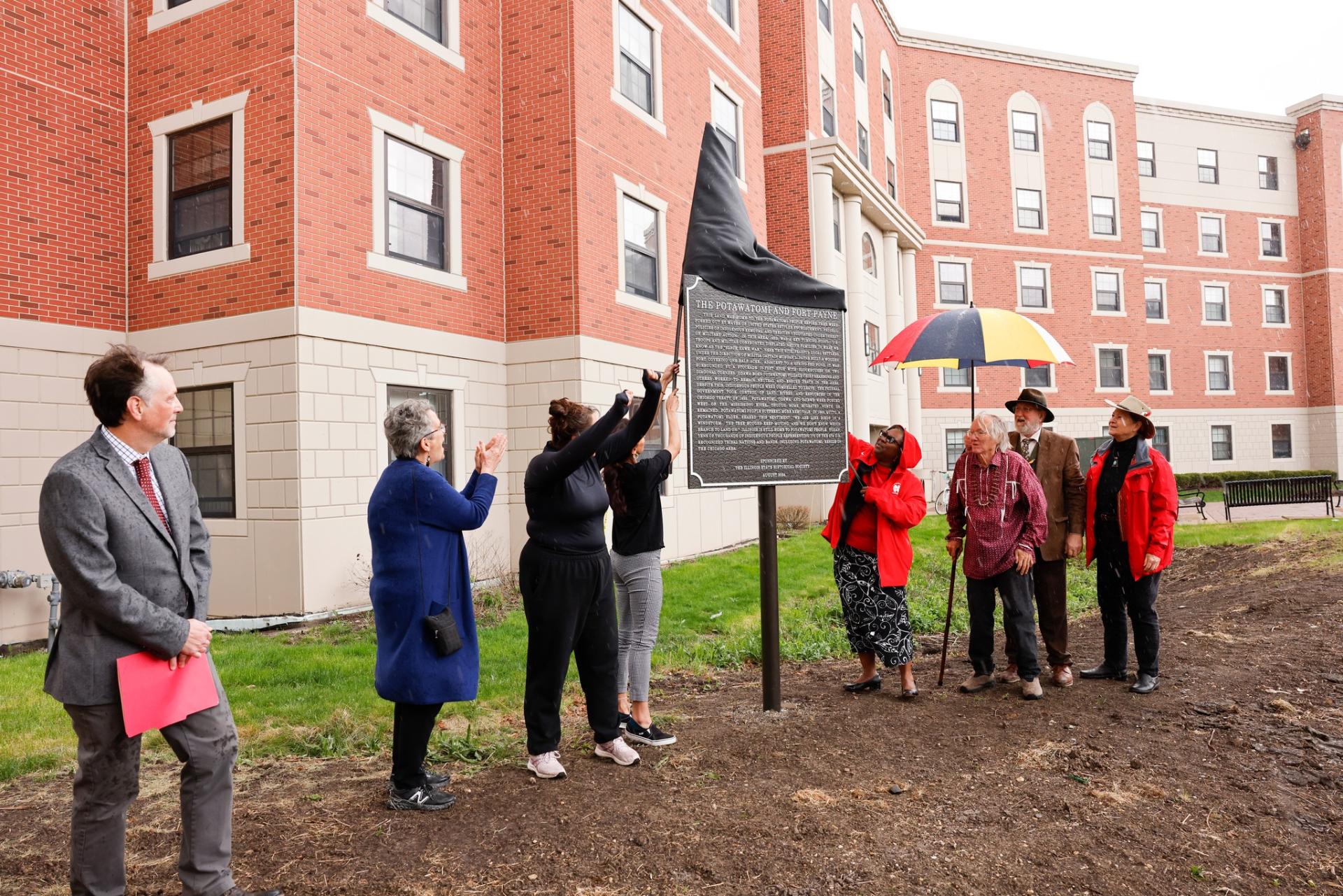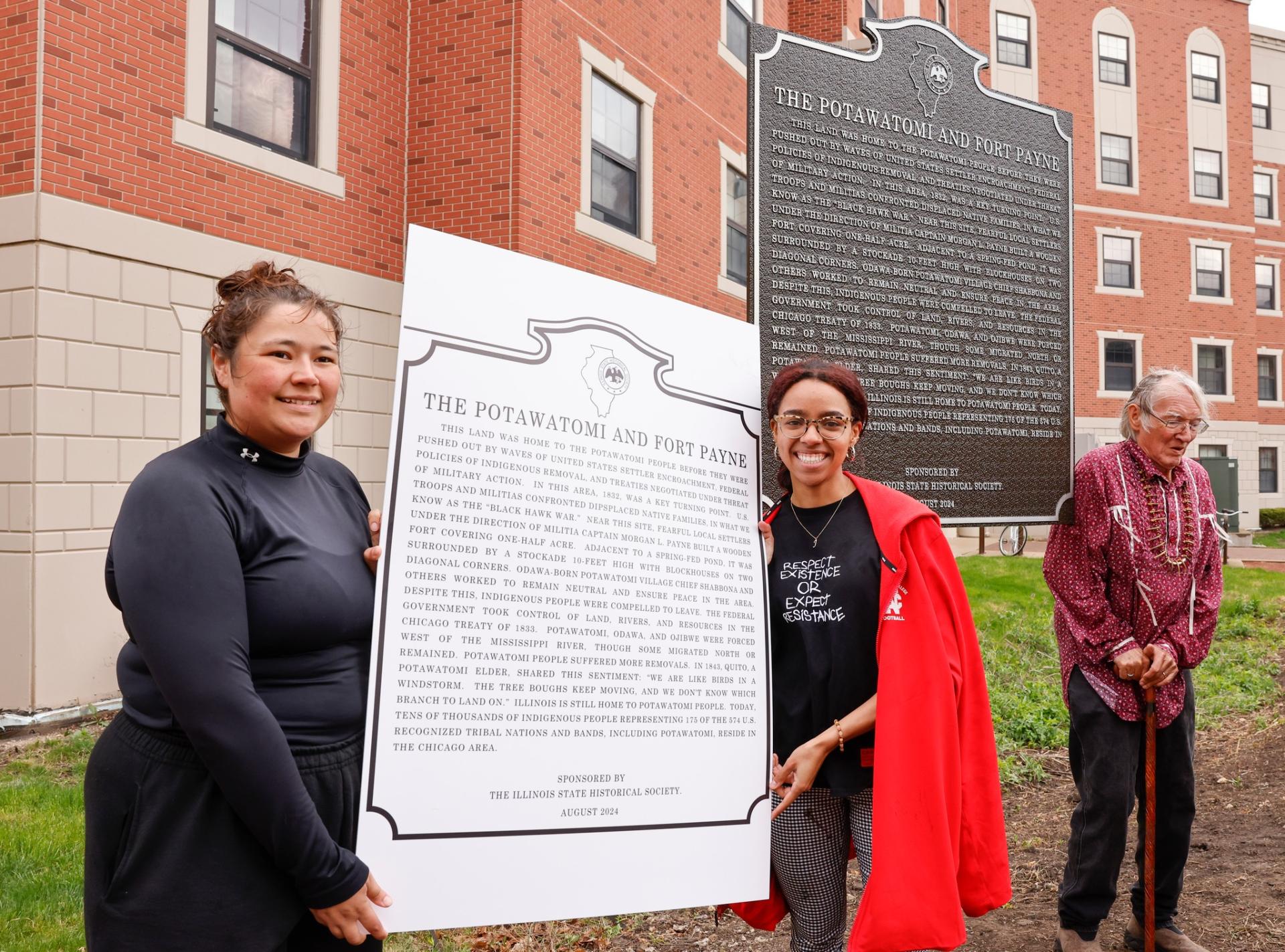North Central News
North Central College dedicates new historical marker on campus
Apr 29, 2024
On Tuesday, April 23, North Central College held a ceremony to dedicate a new historical marker on campus. The marker is placed between New Hall and the Parking Pavilion, replacing a previous historical marker that commemorated the building of Fort Payne in 1832 on the land that is now the North Central campus.
The existing marker was both historically inaccurate regarding the events of the 1832 Black Hawk War and insensitive to Native American culture. Students, faculty, staff and others expressed concern about the marker and sought a more accurate replacement. A team of North Central students supported by faculty from several disciplines worked together to make it happen. The team was led by history and secondary education major Raygn Jordan '24 and included faculty members Dr. Luke Franks, associate professor and chair of history, and Dr. Ann Keating, Dr. C. Frederick Toenniges Professor of History.
In creating a more accurate historical marker, the team consulted with several local historical organizations: Naper Settlement; the Naperville Daughers of the American Revolution (DAR); the DuPage County Historical Society; the DuPage County Historical Museum; the Illinois State Historical Society (ISHS); and members of the Potawatomi Nation. The ISHS funded the replacement marker and the College’s operations team installed the new plaque. The new language on the plaque is provided later in this article.
"I want to thank the team of students and faculty, and the many community members locally and statewide, for employing their academic disciplines and professional expertise to ensure future visitors to the site will be presented with a more accurate depiction of the Black Hawk War events," said President Anita Thomas. "Dedicating an accurate historical marker is aligned with our mission as a higher education institution and consistent with how we will approach our diversity, equity, inclusion, belonging, and justice work."
The event was covered locally on television by Naperville Community Television (NCTV17).
The new historical marker language is proudly presented here:
“The Potawatomi and Fort Payne (approved by Illinois State Historical Society, 1/7/24)
This land was home to the Potawatomi people before they were pushed out by waves of United States settler encroachment, federal policies of Indigenous removal, and treaties negotiated under threat of military action. In this area, 1832 was a key turning point. U.S. troops and militias confronted displaced Native families, in what we know as the 'Black Hawk War.'
Near this site, fearful local settlers under the direction of militia Captain Morgan L. Payne built a wooden fort covering one-half acre. Adjacent to a spring-fed pond, it was surrounded by a stockade 10-feet high with blockhouses on two diagonal corners. Odawa-born Potawatomi village chief Shabbona and others worked to remain neutral and ensure peace in the area. Despite this, Indigenous people were compelled to leave. The federal government took control of land, rivers, and resources in the Chicago Treaty of 1833. Potawatomi, Odawa, and Ojibwe were forced west of the Mississippi River, though some migrated north or remained. Potawatomi people suffered more removals. In 1843, Quito, a Potawatomi elder, shared this sentiment: “We are like birds in a windstorm. The tree boughs keep moving, and we don’t know which branch to land on.”
Illinois is still home to Potawatomi people. Today, tens of thousands of Indigenous people representing 175 of the 574 U.S. recognized tribal nations and bands, including Potawatomi, reside in the Chicago area.”

Left to right: Dr. Franks, Dr. Keating, Raygn Jordan, President Thomas, George Godfrey of the Citizen Potawatomi Nation, Mary Lou Wehrli of the Naperville Outdoor Alliance, and Bill Furry, executive director of the ISHS.



Above: Raygn Jordan receives a reproduction of the new historical marker.

Above: Jordan joins her fellow students, Dr. Thomas, Mary Lou Wehrli and George Godfrey in front of the new marker.
